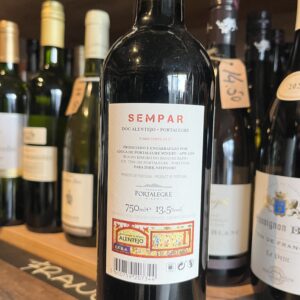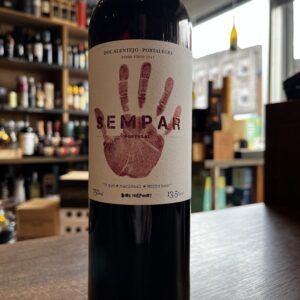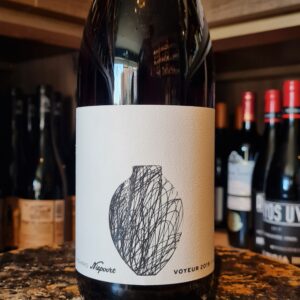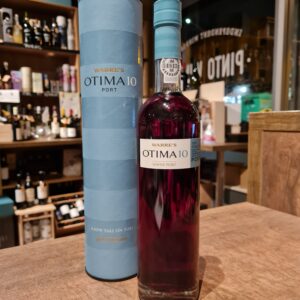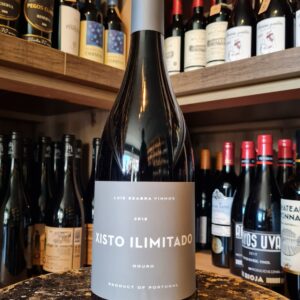-
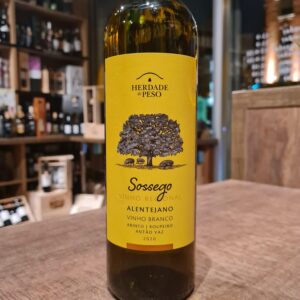 Sogrape Vinhos has been investing in the classic winegrowing regions of Portugal since it was set up in 1942. With a strong presence in the regions of Dão, Douro and (MInho) Vinhos Verdes, their entrance into the Alentejo — the winegrowing region with the highest growth rate in the country — was a natural step. Herdade do Peso Sossego Branco offers the authenticity and immediate passion of Alentejo flavors in a refreshing and aromatic wine. Herdade do Peso is the brand that revitalizes the deepest essence of the region, brought to the surface by the science and know-how of Sogrape Vinhos. The result is the production of exuberant and attractive wines, whose flavors, aromas and colors remind us of life at its best, just like the region where they are born. Sossego White is a refreshing wine that is full of flavour, perfect when served on its own or as na aperitif. It is an excellent accompaniment to various fish dishes, white meats and a variety of salads.
Sogrape Vinhos has been investing in the classic winegrowing regions of Portugal since it was set up in 1942. With a strong presence in the regions of Dão, Douro and (MInho) Vinhos Verdes, their entrance into the Alentejo — the winegrowing region with the highest growth rate in the country — was a natural step. Herdade do Peso Sossego Branco offers the authenticity and immediate passion of Alentejo flavors in a refreshing and aromatic wine. Herdade do Peso is the brand that revitalizes the deepest essence of the region, brought to the surface by the science and know-how of Sogrape Vinhos. The result is the production of exuberant and attractive wines, whose flavors, aromas and colors remind us of life at its best, just like the region where they are born. Sossego White is a refreshing wine that is full of flavour, perfect when served on its own or as na aperitif. It is an excellent accompaniment to various fish dishes, white meats and a variety of salads. -
Out of stock
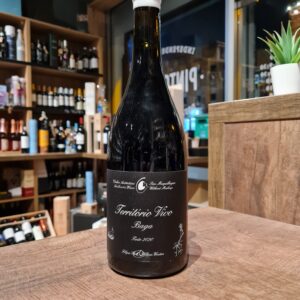 This ''Território Vivo'' is a delicate Baga, it reflects the true term ''living Terroir''. The heritage of old vineyards of the emblematic Baga grape is a richness to be relished. Some of the vines are 80 years old. The subsoils are chalky clay and the vineyards are South East oriented on fairly steep slopes. This particular vintage has fantastic story that could've gone South and thus an unforgettable harvest. They had an attack of rabbits on all of their old vines of Baga. They ate all of the grapes up to 30cm high of the ground. Inedvertently this produced high quality juice but left Filipa and William with the tiniest crops. Producing wine close to nature without pesticides and herbicides can be quite a challenge, certanly when the territory is quite alive!! Serve it with elegant glasses at the temperature of 16-18c and it is highly recommended to pair it with refined foods( not too spicy), Fillet of beef, veal, pigeon, duck and creamy cheeses.
This ''Território Vivo'' is a delicate Baga, it reflects the true term ''living Terroir''. The heritage of old vineyards of the emblematic Baga grape is a richness to be relished. Some of the vines are 80 years old. The subsoils are chalky clay and the vineyards are South East oriented on fairly steep slopes. This particular vintage has fantastic story that could've gone South and thus an unforgettable harvest. They had an attack of rabbits on all of their old vines of Baga. They ate all of the grapes up to 30cm high of the ground. Inedvertently this produced high quality juice but left Filipa and William with the tiniest crops. Producing wine close to nature without pesticides and herbicides can be quite a challenge, certanly when the territory is quite alive!! Serve it with elegant glasses at the temperature of 16-18c and it is highly recommended to pair it with refined foods( not too spicy), Fillet of beef, veal, pigeon, duck and creamy cheeses. -
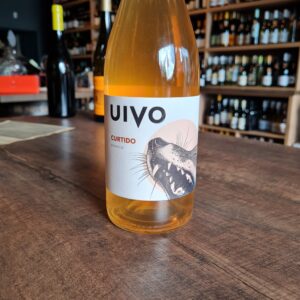 Uivo, a howl back to Nature! Naturally farmed Moscatel Galego, Branco Wine grapes with minimal intervention in the cellar, 4 months of skin contact in cement tanks. Folias de Baco was started in 2007 by young, innovative winemaker, Tiago Sampaio, who was inspired by his grandfather’s vineyard work. He has a vivacious curiosity and loves to experiment at every step of the winemaking/growing processes. He has studied agricultural engineering and has a PhD in Viticulture and Enology from Oregon State University, where he picked up on modern philosophies and aesthetics of winemaking, never forgetting his Douro roots. Folias de Baco is in the Alto Douro, in the sub-region of Cima-Corgo where the land is very tough and challenging at a higher altitude, but it is an expression of traditional melding with modern techniques. The ‘Uivo Curtido’ is comprised of 100% moscatel galego from 35+ year old vines in soils spattered with schist and granite. It is unfined and unfiltered. As tasty as it looks. Organically grown, low-intervention/natural wine, vegan. Have fun with it
Uivo, a howl back to Nature! Naturally farmed Moscatel Galego, Branco Wine grapes with minimal intervention in the cellar, 4 months of skin contact in cement tanks. Folias de Baco was started in 2007 by young, innovative winemaker, Tiago Sampaio, who was inspired by his grandfather’s vineyard work. He has a vivacious curiosity and loves to experiment at every step of the winemaking/growing processes. He has studied agricultural engineering and has a PhD in Viticulture and Enology from Oregon State University, where he picked up on modern philosophies and aesthetics of winemaking, never forgetting his Douro roots. Folias de Baco is in the Alto Douro, in the sub-region of Cima-Corgo where the land is very tough and challenging at a higher altitude, but it is an expression of traditional melding with modern techniques. The ‘Uivo Curtido’ is comprised of 100% moscatel galego from 35+ year old vines in soils spattered with schist and granite. It is unfined and unfiltered. As tasty as it looks. Organically grown, low-intervention/natural wine, vegan. Have fun with it -
 In 2003, José Ribeiro Vieira purchased a four hectare vineyard in the foothills of Serra de Aire of Cortes, in the Alta Estremadura, near Lisbon. Vale da Mata pays tribute to Vieira’s winemaker father, Manuel, who claimed that Vale de Mata was the site where he succeeded in producing his best wines. The Vale de Mata project respects the expression of its terroir, cultivating the vines sustainably and using minimal intervention in the winery. Manuel gave this wine its name and his granddaughter Catarina Viera has followed in his footsteps, continuing his winemaking legacy. In 2018. Vale da Mata is the name of a small, old vineyard located in the foothills of Serra de Aire, in Cortes. The vineyard has a maritime climate and is influenced by the Atlantic Ocean. The parcel is just a few hectares and is situated on a steep terrain with rocky soil. The land is extremely hard to work and is cultivated manually, with winter pruning and green harvesting taking place by hand. Protected to the north, it has good sunlight exposure throughout the day and is surrounded by olive trees, fig trees, walnuts and shrubs. Vale de Mata is associated with several sustainable programmes; they are a member of the FSC and grow all their grapes according to organic philosophies. The vines are trained according to the Cordon Royat method and the grapes are manually harvested at optimum maturity.
In 2003, José Ribeiro Vieira purchased a four hectare vineyard in the foothills of Serra de Aire of Cortes, in the Alta Estremadura, near Lisbon. Vale da Mata pays tribute to Vieira’s winemaker father, Manuel, who claimed that Vale de Mata was the site where he succeeded in producing his best wines. The Vale de Mata project respects the expression of its terroir, cultivating the vines sustainably and using minimal intervention in the winery. Manuel gave this wine its name and his granddaughter Catarina Viera has followed in his footsteps, continuing his winemaking legacy. In 2018. Vale da Mata is the name of a small, old vineyard located in the foothills of Serra de Aire, in Cortes. The vineyard has a maritime climate and is influenced by the Atlantic Ocean. The parcel is just a few hectares and is situated on a steep terrain with rocky soil. The land is extremely hard to work and is cultivated manually, with winter pruning and green harvesting taking place by hand. Protected to the north, it has good sunlight exposure throughout the day and is surrounded by olive trees, fig trees, walnuts and shrubs. Vale de Mata is associated with several sustainable programmes; they are a member of the FSC and grow all their grapes according to organic philosophies. The vines are trained according to the Cordon Royat method and the grapes are manually harvested at optimum maturity. -
Out of stock
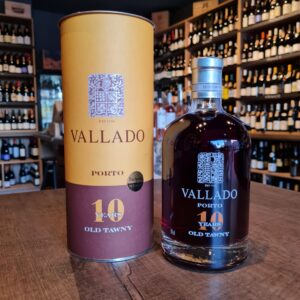 Quinta do Vallado, established in 1716, is one of the oldest and most famous Quintas in the Douro Valley. It once belonged to the legendary Dona Antonia Adelaide Ferreira, and still belongs to her descendents. Produces both still and port wines. This eighteenth-century Douro wine estate is actually one of the most modern-looking in Portugal. Although the team uses the traditional panoply of indigenous grapes, its methods are bang up to date and the results are nothing short of sensational. Tawny ports are wines usually made from red grapes that are aged in wooden barrels exposing them to gradual oxidation and evaporation. As a result of this oxidation, they mellow to a golden-brown color. The exposure to oxygen imparts "nutty" flavours to the wine, which is blended to match the house style. This port is really best enjoyed with a good strong cheese board. Think mature hard cheeses and salty blues. Rich and flavoursome to match with the intense flavours of the port.
Quinta do Vallado, established in 1716, is one of the oldest and most famous Quintas in the Douro Valley. It once belonged to the legendary Dona Antonia Adelaide Ferreira, and still belongs to her descendents. Produces both still and port wines. This eighteenth-century Douro wine estate is actually one of the most modern-looking in Portugal. Although the team uses the traditional panoply of indigenous grapes, its methods are bang up to date and the results are nothing short of sensational. Tawny ports are wines usually made from red grapes that are aged in wooden barrels exposing them to gradual oxidation and evaporation. As a result of this oxidation, they mellow to a golden-brown color. The exposure to oxygen imparts "nutty" flavours to the wine, which is blended to match the house style. This port is really best enjoyed with a good strong cheese board. Think mature hard cheeses and salty blues. Rich and flavoursome to match with the intense flavours of the port. -
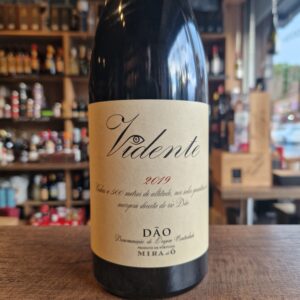 This wine rises from 500 meters above sea level in the granite soils of the right bank of the Dão. These low yield vines are about 30 years old and produce high quality grapes of the varieties Jaen, Alfrocheiro, Tinta Pinheira, Tinta Roriz and Touriga Nacional. This wine is a very personal vision over the Dão and its wines, enhancing the elegance and freshness that are natural to this region. True value in wine. Food orientated but aren't all the wines?
This wine rises from 500 meters above sea level in the granite soils of the right bank of the Dão. These low yield vines are about 30 years old and produce high quality grapes of the varieties Jaen, Alfrocheiro, Tinta Pinheira, Tinta Roriz and Touriga Nacional. This wine is a very personal vision over the Dão and its wines, enhancing the elegance and freshness that are natural to this region. True value in wine. Food orientated but aren't all the wines? -
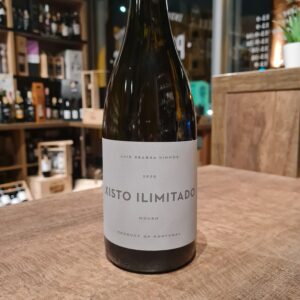 Another under the radar Portuguese White. This drop is now considered one of the new best contemporanean whites in Portugal. Produced by Luis Seabra, who worked for more than 10 years as an oenologist for Dirk Niepoort and finally started to follow his own path in 2012. The name he gives to his wines is indicative of his vision of wine: Xisto (Schist). He makes very pure wines that reflect their terroir. Luis Seabra sets a new standard in the Douro with his pure wines. Xisto Ilimitado, is a Portuguese analogue of the idea of a "village-level" Burgundy. A blend of six varieties planted in three sub-areas of the Douro, Ilimitado is a glimpse of the appellation's schist soil. Luis Seabra, has concentrated his production on the different soil types of the valley. Bright, concentrated and fresh, Xisto Ilimitado is an excellent introduction to the new Douro. Vineyards located in Cima Corgo. The vines are between 30 and 45 years old, planted in micaceous schist at an altitude of 500 to 600 m, and are a sub-region that experiences extreme highs and lows in terms of temperature, with one of the largest day-night temperature deltas in Portugal. As such, the fruit experiences an extended resting period. Annual rainfall of 400 mm typical of the region. Goes wonderfully with roasted poultry, white fish and seafood, and especially with the spiciest preparations
Another under the radar Portuguese White. This drop is now considered one of the new best contemporanean whites in Portugal. Produced by Luis Seabra, who worked for more than 10 years as an oenologist for Dirk Niepoort and finally started to follow his own path in 2012. The name he gives to his wines is indicative of his vision of wine: Xisto (Schist). He makes very pure wines that reflect their terroir. Luis Seabra sets a new standard in the Douro with his pure wines. Xisto Ilimitado, is a Portuguese analogue of the idea of a "village-level" Burgundy. A blend of six varieties planted in three sub-areas of the Douro, Ilimitado is a glimpse of the appellation's schist soil. Luis Seabra, has concentrated his production on the different soil types of the valley. Bright, concentrated and fresh, Xisto Ilimitado is an excellent introduction to the new Douro. Vineyards located in Cima Corgo. The vines are between 30 and 45 years old, planted in micaceous schist at an altitude of 500 to 600 m, and are a sub-region that experiences extreme highs and lows in terms of temperature, with one of the largest day-night temperature deltas in Portugal. As such, the fruit experiences an extended resting period. Annual rainfall of 400 mm typical of the region. Goes wonderfully with roasted poultry, white fish and seafood, and especially with the spiciest preparations


